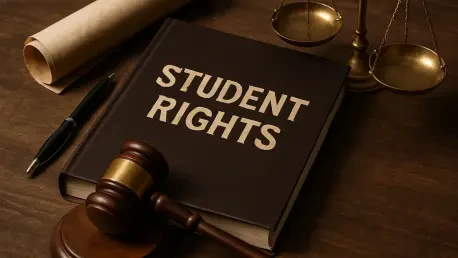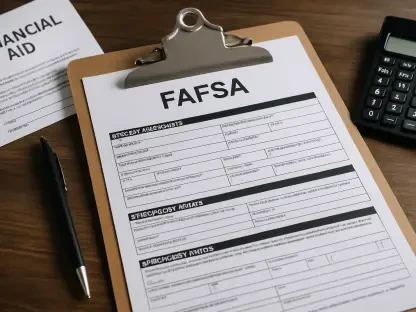Imagine a scenario where the agency tasked with protecting students from discrimination faces a crippling reduction in its workforce, struggling to manage thousands of complaints with only half its staff. This isn’t a mere possibility—it’s the harsh reality unfolding within the U.S. Department of Education’s Office for Civil Rights (OCR). A recent court ruling has authorized severe staff cuts, sparking intense debate over whether student protections are now at risk. This decision comes at a critical moment, as caseloads soar and issues of equity in schools dominate national discourse. Dive into a crisis that could redefine educational fairness for millions.
A Crisis Unfolding in Schools
The foundation of student rights is under threat as the OCR grapples with unprecedented challenges. Tasked with enforcing federal civil rights laws, this agency has long been a safeguard against discrimination in education. However, a ruling by the 1st U.S. Circuit Court of Appeals has permitted the Department of Education to cut nearly half of OCR’s staff, a move that could severely impair its ability to respond to violations effectively. This isn’t just an administrative setback; it’s a profound shift that raises serious concerns about the future of equal access in classrooms nationwide.
Beyond the headlines, the timing of these reductions adds fuel to the fire. With complaints flooding in at a record pace, the agency is already stretched thin. The potential for delayed investigations or unresolved cases looms large, leaving students and families in limbo. Schools, often the first line of defense against inequity, may find themselves navigating complex issues without adequate federal oversight. This situation demands attention, as the stakes couldn’t be higher for those relying on OCR to uphold justice.
Why These Cuts Matter Now
The significance of these staff reductions cannot be overstated, especially given the current climate in education. OCR serves as the primary enforcer of laws like the Civil Rights Act, addressing discrimination based on race, gender, disability, and more. Yet, with complaints skyrocketing—reaching 19,201 in the most recent annual tally, including 12,709 K-12 cases—the agency’s capacity is under immense strain. These numbers reflect a growing cry for help from students and families facing bias, making the timing of workforce cuts particularly alarming.
Moreover, the legal backdrop intensifies the concern. The appeals court’s decision to permit layoffs, despite ongoing litigation, signals a prioritization of fiscal constraints over immediate civil rights enforcement. This ruling comes as OCR struggles to manage a caseload that has more than doubled in recent years. For every delayed case, a student’s right to a fair education hangs in the balance, underscoring the urgency of maintaining robust staffing levels during such turbulent times.
The ripple effects extend beyond statistics to the lived experiences of those affected. Schools grappling with issues like racial disparities or inadequate accommodations for students with disabilities rely on OCR’s guidance and intervention. With fewer staff to handle investigations, the risk of systemic inequities festering unchecked grows. This moment serves as a critical test of whether budgetary decisions will overshadow the fundamental promise of educational equity.
Unpacking the Impact of Staff Reductions
Delving into the consequences of these layoffs reveals a multi-layered crisis. Operationally, cutting half of OCR’s workforce—despite efforts to reinstate over 260 employees earlier this year—directly hampers the agency’s ability to process complaints. With thousands of K-12 cases awaiting resolution, backlogs are inevitable, potentially leaving students vulnerable for months or even years. This isn’t just about slower response times; it’s about diminished accountability for schools failing to meet civil rights standards.
Financially, the cuts expose a bitter irony. While laid-off staff were on administrative leave, the department spent $1 million weekly to maintain their status, a hefty burden on public funds. Though the court ruling alleviates this cost, it does so at the expense of OCR’s mission. Taxpayers are caught in a bind—footing the bill for inefficiencies while student protections erode. This fiscal trade-off sparks questions about whether short-term savings justify long-term harm to educational fairness.
Legally, the ongoing battle adds another dimension of uncertainty. The journey from a district court injunction to block layoffs to an appeals court reversal reflects deeper tensions over how civil rights enforcement fits into budget priorities. Each ruling shapes the landscape of student protections, with the potential to set precedents for years to come. As these legal skirmishes unfold, the immediate reality remains: fewer staff means less capacity to safeguard the rights of the nation’s most vulnerable students.
Voices from the Frontlines and Legal Perspectives
Those closest to the issue are not holding back their concerns about the fallout from these reductions. Senior Attorney Sean Ouellette of Public Justice, representing plaintiffs in a high-profile case challenging the layoffs, issued a stark warning: “This ruling risks real harm to students and families relying on OCR to fight discrimination.” His words echo the fears of many advocates who see the agency as a cornerstone of educational equity, rooted in historic rulings like Brown v. Board of Education that dismantled segregation.
Legal experts also point to a troubling judicial trend. The appeals court’s decision aligns with a broader Supreme Court ruling earlier this year, favoring administrative flexibility over immediate staff retention. This suggests a shift toward prioritizing governmental discretion, even when it conflicts with civil rights mandates. For families awaiting OCR’s intervention on issues like harassment or unequal treatment, these legal nuances translate into real-world delays and frustration.
Amid the data and court rulings, the human element stands out. Advocacy groups emphasize that each complaint represents a student or family seeking redress—whether it’s a child denied accommodations or a community battling systemic bias. With OCR’s diminished capacity, these voices risk going unheard, fueling a chorus of calls for urgent action. The clash between legal outcomes and on-the-ground realities paints a vivid picture of an agency caught in a precarious balancing act.
Navigating the Fallout: Potential Solutions
Amid the uncertainty, there are pathways to mitigate the damage and protect student rights. Schools can take proactive steps by strengthening internal policies on discrimination, ensuring staff are trained to identify and address issues swiftly. Such measures won’t replace OCR’s oversight but can reduce the volume of complaints reaching federal levels. Local accountability becomes paramount when national resources falter.
Advocacy groups and policymakers also have a role to play in turning the tide. Pushing for legislative solutions to secure funding for civil rights enforcement is critical—perhaps by reallocating federal budgets from less urgent sectors. Public campaigns can amplify the issue, rallying support to pressure decision-makers into prioritizing OCR’s mission. Community engagement ensures that the plight of students remains in the spotlight, refusing to let it fade amid bureaucratic debates.
For families and students, alternative avenues offer some hope. Documenting issues meticulously and escalating them through state education agencies can provide interim relief while OCR rebuilds its capacity. Staying abreast of ongoing litigation, including potential appeals by advocacy organizations, empowers communities to hold authorities accountable. These steps, though imperfect, serve as a buffer against the immediate impacts of staff cuts, preserving the fight for equity until systemic solutions emerge.
In reflecting on this challenging chapter, the urgency to act became clear as the cuts to OCR’s staff unfolded. The legal battles revealed a stark divide between fiscal priorities and civil rights imperatives, leaving many to wonder how long students could wait for justice. Looking back, the path forward rested on collective efforts—schools fortifying their own defenses, advocates lobbying for restored funding, and communities refusing to let discrimination go unchallenged. The hope lingered that future policies would rebuild OCR’s strength, ensuring that no student’s rights were sacrificed on the altar of budget constraints.









